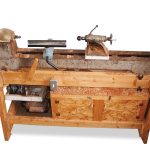We may receive a commission when you use our affiliate links. However, this does not impact our recommendations.
 As you recall, a few months ago, I wrote about a beautiful chair made of solid mahogany that we bought and found out that it was sadly damaged during shipping. The vendor sent us a replacement, but I decided to fix the broken piece anyway so we could use it. At the time, I thought my mending job was complete, but I was wrong. A few weeks passed, and the replacement chair broke in different areas. I restored it, too, hoping I would not have to deal with any of these chairs again.
As you recall, a few months ago, I wrote about a beautiful chair made of solid mahogany that we bought and found out that it was sadly damaged during shipping. The vendor sent us a replacement, but I decided to fix the broken piece anyway so we could use it. At the time, I thought my mending job was complete, but I was wrong. A few weeks passed, and the replacement chair broke in different areas. I restored it, too, hoping I would not have to deal with any of these chairs again.
Read the prior entries: Part 1 Part 2 Part 3 Part 4 Part 5

Unfortunately, I was very naive, as a few weeks later, the replacement chair’s upholstered seat frame broke too. While some might assume that perhaps I should consider going on a diet, the truth is the frame broke because its maker used a defective part that had a huge knot in it, which gave out as I sat on it.

Since I didn’t have the time to rebuild a new frame, reconnect and retention the straps, line them with the foam, etc. I decided to see if I could secure the broken part by connecting and securing a batten along its length.

I used an old plastic card to cushion the heel of the prying tool to prevent it from digging in and tearing the fabric.
After removing some staples to access the broken part, I discovered the full extent of the damage and concluded that a batten could do the job. I also found that part of the bridal joint (in one of the frame’s scorners) had a crack.


The Reconstruction
First, I poured CV adhesive into the bridal joint’s crack and clamped it for a few minutes.

 Then I shaped a batten and drilled it with pilot holes and countersinks to allow screws to travel through it and into the broken parts.
Then I shaped a batten and drilled it with pilot holes and countersinks to allow screws to travel through it and into the broken parts.


I then tried to see if I could manually and without clamps persuade the batten to press against the broken part. It was not easy, and I had to recruit some clamps to overcome the tension forces of the straps. I also evaluated another challenge: forcing the broken parts to line vertically with the plane of the frame.

Notice how the broken part pops up from the frame’s plane. I had to align it with the frame by pushing it down and using clamps to pull the pieces outward towards the batten.


Since I wasn’t sure if I could manage both tasks– straightening and flattening the fractured part (flush & flat), I decided to make a few temporary cauls that would help align the pieces until I managed to drive all the screws in place.




 However, after all this fuss, I didn’t have to use the cauls since I could pull the broken part flush with the batten using clamps and level it with the frame using my hands alone.
However, after all this fuss, I didn’t have to use the cauls since I could pull the broken part flush with the batten using clamps and level it with the frame using my hands alone. 
I used Titebond III glue (long open time) and hardened wood screws to secure the new batten to the broken frame.
After the glue dried completely, I secured the corners of the frame to the batten with steel-made L- brackets to toughen that area.

This is not a conservers’ quality restoration but rather a fixer-upper approach for a chair that never fails to fail again and again. Let’s see what parts will require my attention next time.


Here are some supplies and tools we find essential in our everyday work around the shop. We may receive a commission from sales referred by our links; however, we have carefully selected these products for their usefulness and quality.








